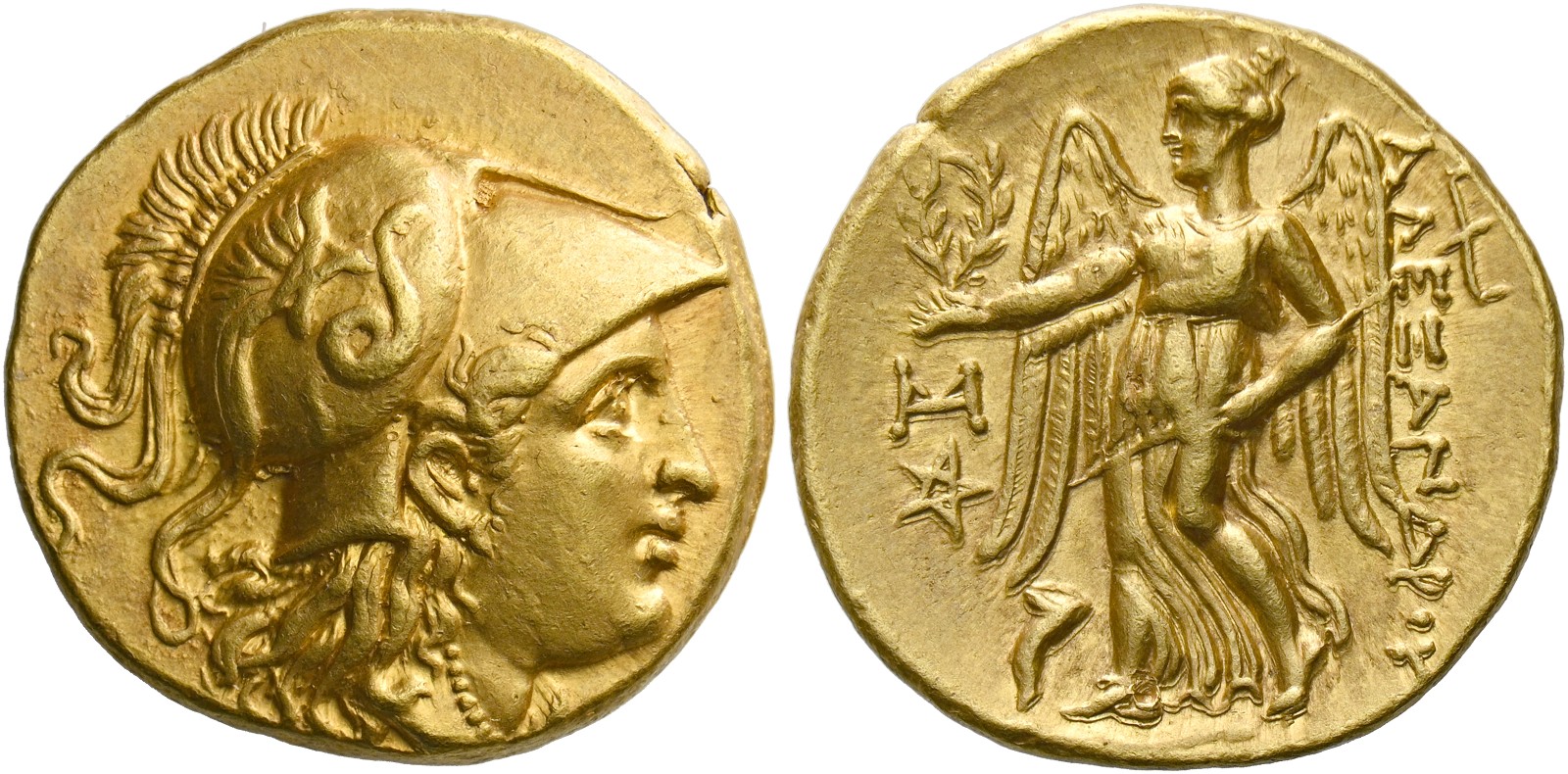Abydus (Alexander the Great), gold, staters (325-301 BCE)
From SILVER
325 BCE - 301 BCE Gold 155,764 kg
Description
| ObverseInscription or printing placed on the obverse.: | Head of Athena r., wearing triple crested Corinthian helmet, bowl decorated with snake, and pearl necklace. |
| ReverseInscription or printing placed on the reverse.: | AΛΕΞΑΝΔΡΟΥ (Greek).Nike advancing l., holding wreath and stylus, in l. field, monogram / pentagram and, beneath r. wing, cornucopia |
Mint and issuing power
| MintIdentifies the place of manufacture or issue of a numismatic object.: | Abydus | Ancient regionAncient region.: | Troas | Modern countryModern country: Turkey | AuthorityIdentifies the issuing power. The authority can be "pretended" when the name or the portrait of X is on the coin but he/she was not the issuing power. It can also be "uncertain" when there is no mention of X on the coin but he/she was the issuing power according to the historical sources: | Alexander III the Great (Argead king, 336-323 BC) |
Chronology
| FromIdentifies the initial date in a range assigned in a numismatic context. | 325 BCE | toIdentifies the final date in a range assigned in a numismatic context.. | 301 BCE | PeriodTime period of the numismatic object.: Classical and Hellenistic |
Physical description
| MetalThe physical material (usually metal) from which an object is made.: | Gold |
Median weightMedian of the weights of numismatic objects (in grams). in grams | 8.55 | DenominationTerm indicating the value of a numismatic object. Examples: tetradrachm, chalkous, denarius.: | stater |
StandardStandard.: | Attic |
Image

RQEMH 204 - Abydus, gold, stater, 325-301 BC.jpg [1]
References
| Die study referencePublication of the study: | Thompson 19911Thompson 1991 | ||
| Coin series referenceReference to coin series study: | Sear II2Sear II, n° 6702-6707, Price 19913Price 1991, n° 1497, 1504, 1518-1519, P28-P39, RQEMH4RQEMH, n° 204 | ||
| Coin series web referenceCoin series web references: | |||
Obverse dies distribution
| FrequencyFrequency of specimen in distribution. ᵖ | Number of obversesNumber of obverse dies. ᵖ (o) | % (o) | Number of coinsNumber of coins. (n) | % (n) | Die nameName(s) of the die(s). |
| 1 | 23 | 31.51 | 23 | 10 | 143, 162, 163, 164, 166, 170, 216, 291, 292, 330, 332, 334, 339, 344, 346, 347, 363, 365, 366, 368, 371, 398, 399 |
| 2 | 15 | 20.55 | 30 | 13.04 | 2, 30, 128, 130, 145, 146, 147, 167, 168, 171, 172, 337, 345, 349, 396 |
| 3 | 12 | 16.44 | 36 | 15.65 | 138, 144, 160, 161, 173, 328, 329, 331, 342, 364, 372, 373 |
| 4 | 9 | 12.33 | 36 | 15.65 | 129, 137, 174, 336, 338, 348, 367, 369, 374 |
| 5 | 4 | 5.48 | 20 | 8.7 | 140, 165, 333, 370 |
| 6 | 3 | 4.11 | 18 | 7.83 | 1, 169, 335 |
| 7 | 3 | 4.11 | 21 | 9.13 | 148, 340, 397 |
| 10 | 1 | 1.37 | 10 | 4.35 | 343 |
| 11 | 1 | 1.37 | 11 | 4.78 | 139 |
| 12 | 1 | 1.37 | 12 | 5.22 | 142 |
| 13 | 1 | 1.37 | 13 | 5.65 | 141 |
| Total | 73 of 73 | 100.01 | 230 of 230 | 100 |
Reverse dies distribution
no distribution is available
Quantification
| Number of obversesNumber of obverse dies. ᵖ (o) | 73 | Number of singletons (o1)The number of singleton coins. ᵖ | 23 |
| Number of reverse diesNumber of reverse dies. (r) | 115 | Number of coinsNumber of coins. (n) | 230 |
| Coins per obverse dieNumber of coins per obverse die. (n/o) | 3.15 | Coins per reverse dieNumber of coins per reverse die. (n/r) | 2 |
| Reverse per obverse ratioRatio of obverse dies divided by reverse dies. (r/o) | 1.58 | Percentage of singletons (o1)number of coins (n) divided by the number of singletons (o1) ᵖ | 31.51 % |
| Original number of dies (O) (Carter 1983 formula)The estimation of the number of coins according to Carter 1983 ᵖ | 91.09 | Coins struck if 20,000 as average productivity per dieCoins made if the average productivity for obverses (according to Carter) is 20,000. ᵖ | 1,821,800 |
| Original number of dies (O) (Esty 2011 formula)The estimation of the number of coins according to the singleton formula in Esty 2011 ᵖ (O) | 106.94 | Survival rate if 20,000 as average productivity per dieSurvival rate if average productivity is 20,000. ᵖ | 0.00013 |
| Coverage (o = % of O) (Esty 1984 formula)Esty 1984 - coverage (% of O) ᵖ (o = % of O) | 90% | Die productivity if survival rate 1/2,000Average productivity if survival rate is 1/2,000. ᵖ | 5,049.95 |
| Weight of silver (in kg) if 20,000 coins per die (O = Carter formula)Carter 1983 * Median weight * 20000 (*10 if gold or electrum) ᵖ | 155,764 kg <br /> 155,764 kg | Die productivity if survival rate 1/5,000Average productivity if survival rate is 1/5,000. ᵖ | 12,624.88 |
Remarks
Most likely one single workstation Certainly military